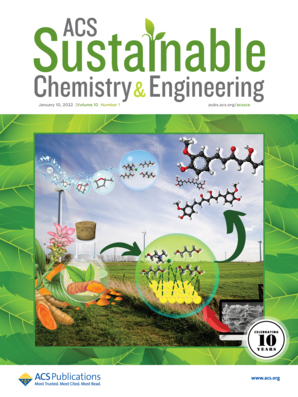了解表面温度和氢自由基对氢等离子体还原氧化铁的贡献
IF 7.3
1区 化学
Q1 CHEMISTRY, MULTIDISCIPLINARY
引用次数: 0
摘要
微波驱动的常压等离子体在提高氢的反应活性以脱碳还原氧化铁方面引起了人们的关注。然而,该过程通常在高温下操作,其中除了任何等离子体激活的物质(如原子氢)外,反应还涉及分子氢。在这项工作中,通过将来自固态放大器的微波辐射耦合到被气流包围的天线上,开发了等离子体源,以产生自由射流,从而能够在低温(<500°C)下处理材料表面。用红外热分析法测量了等离子体处理过程中的表面温度,控制实验证实,在这些温度下,氢分子的还原被动力学抑制。因此,我们能够研究在低温(~ 280 ~ 500°C)下氧化铁的还原以及各种工艺条件的影响。观察到的趋势是根据表面温度和等离子体活化物质(即原子氢)的输运来理解的。解耦这些不同的贡献使得动力学分析和表观活化能的提取为50 kJ/mol,在大气压下原子氢的总体还原,没有分子氢和扩散效应。结果表明,原子氢增强了还原作用,但表面温度仍然起主导作用,这可以指导低温氢等离子体还原铁或其他金属氧化物,以实现钢铁等关键资源的可持续和按需生产。本文章由计算机程序翻译,如有差异,请以英文原文为准。

Understanding the Contribution of Surface Temperature and Hydrogen Radicals to Hydrogen Plasma Reduction of Iron Oxide
Microwave-powered, atmospheric-pressure plasmas have attracted attention to increase the reactivity of hydrogen for decarbonized reduction of iron oxide. However, the processes are often operated at high temperatures where reactions involve molecular hydrogen, in addition to any plasma-activated species such as atomic hydrogen. In this work, a plasma source was developed by coupling microwave radiation from a solid-state amplifier to an antenna surrounded by gas flow, to produce a free jet that enables treatment of a material surface at low temperatures (<500 °C). The surface temperature during plasma treatment was measured by infrared pyrometry, and control experiments confirmed that reduction by molecular hydrogen at these temperatures was kinetically suppressed. We thus were able to study the reduction of iron oxide at low temperature (∼280 to 500 °C) and the effect of various process conditions. The observed trends were understood in terms of the surface temperature and transport of the plasma-activated species, namely atomic hydrogen. Decoupling these various contributions enabled kinetic analysis and the extraction of an apparent activation energy of 50 kJ/mol for the overall reduction by atomic hydrogen at atmospheric pressure, free from molecular hydrogen and diffusional effects. The results show that reduction is enhanced by atomic hydrogen, but surface temperature continues to play a predominant role, which can guide low-temperature hydrogen plasma reduction of iron or other metal oxides for sustainable and on-demand production of critical resources such as steel.
求助全文
通过发布文献求助,成功后即可免费获取论文全文。
去求助
来源期刊

ACS Sustainable Chemistry & Engineering
CHEMISTRY, MULTIDISCIPLINARY-ENGINEERING, CHEMICAL
CiteScore
13.80
自引率
4.80%
发文量
1470
审稿时长
1.7 months
期刊介绍:
ACS Sustainable Chemistry & Engineering is a prestigious weekly peer-reviewed scientific journal published by the American Chemical Society. Dedicated to advancing the principles of green chemistry and green engineering, it covers a wide array of research topics including green chemistry, green engineering, biomass, alternative energy, and life cycle assessment.
The journal welcomes submissions in various formats, including Letters, Articles, Features, and Perspectives (Reviews), that address the challenges of sustainability in the chemical enterprise and contribute to the advancement of sustainable practices. Join us in shaping the future of sustainable chemistry and engineering.
 求助内容:
求助内容: 应助结果提醒方式:
应助结果提醒方式:


